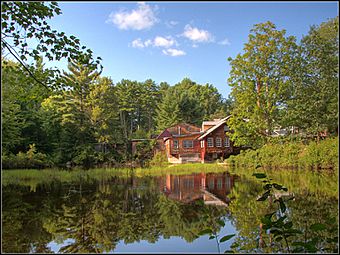Daniel Cragin Mill facts for kids
Quick facts for kids |
|
|
Daniel Cragin Mill
|
|

Water-powered mill
|
|
| Location | West of town of Wilton at the junction of Davisville Road and Burton Hwy |
|---|---|
| Nearest city | Wilton, New Hampshire |
| Area | 4 acres (1.6 ha) |
| Built | Originally built 1817 Mill founded 1858 |
| Built by | Eliphalet Putnam, Daniel Cragin, Whitney Frye |
| NRHP reference No. | 82001681 |
| Added to NRHP | March 23, 1982 |
The Daniel Cragin Mill, known today as Frye's Measure Mill, is a historic watermill that started operating in 1858. This special mill was added to the U.S. National Register of Historic Places in 1982. This means it is recognized as an important place in American history.
What is Frye's Measure Mill?
Frye's Measure Mill is a type of factory that uses the power of water to run its machines. It is located west of Wilton, New Hampshire. The mill was first built in 1817 by Eliphalet Putnam. Later, in 1858, Daniel Cragin founded the mill as we know it today. Whitney Frye also played a big part in its history.
This mill became famous for making wooden measuring tools. These tools were used for things like measuring grain or other dry goods. It was a very important business for the local area.
A Historic Place
The Daniel Cragin Mill, or Frye's Measure Mill, is considered a historic site. In 1982, it was officially listed on the National Register of Historic Places. This is a list of places across the United States that are important to our country's history and culture.
The listing included five main buildings on about 4 acres of land. These buildings show how mills used to operate a long time ago. They help us understand the history of manufacturing and how people used water power.
See also
- Hamblet-Putnam-Frye House, the Frye's summer residence west of the mill
- National Register of Historic Places listings in Hillsborough County, New Hampshire
External links
- Frye's Measure Mill official website: http://www.fryesmeasuremill.com/firstpage.html



